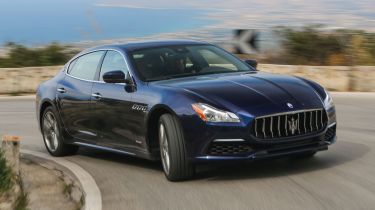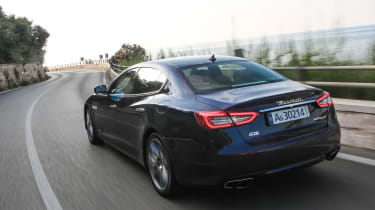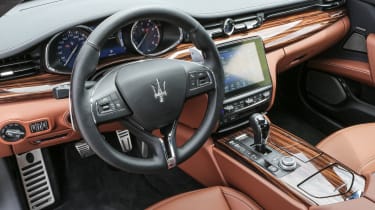New Maserati Quattroporte Diesel 2016 review
Can the new Maserati Quattroporte Diesel compete with the Mercedes S-Class and BMW 7 Series in the executive class?

There is still plenty to admire about the Maserati Quattroporte – it’s a well-made, competent product - but perhaps, unlike days of old, there’s not enough to love, and hence, that willingness to overlook any failings. Given the quality of the new arrivals in this class, that makes it tough to recommend the big Maserati. Shame.
The Maserati Quattroporte is one of the best-looking sports saloons out there, and it's been given a mid-life makeover with a subtle facelift. The biggest change, though, is to the model line-up.
Buyers can now choose from a 'base' model, and two optional trims which take the Quattroporte in one of two directions. 'GranLusso' trim focuses on luxury and style, with 20-inch alloy wheels (an upgrade from 19's) lashings of chrome on the outside and a traditional wood and leather interior.
GranSport, meanwhile, turns the Quattroporte into a real sports saloon, with 21-inch wheels, an aggressive bodykit, and sports seats on the inside.
• Best luxury cars on sale right now
The facelift takes a trained eye to spot, but the most obvious change is to the grille, which is now filled with vertical chrome bars to differentiate it from the smaller Ghibli. Design is entirely subjective, of course, but we think the car still somehow lacks the road presence that a Maserati should possess. There's no denying it's good-looking, though, and it makes a change from the scores of Mercedes E-Class' and BMW 5 Series' driving around.
The 3.0-litre diesel engine puts out a competitive 271bhp, with a linear delivery and acceptable – though unremarkable – refinement. The ‘Active Sound’ generator gives it a gruff voice in Sport mode that will either appeal or soon grate, but a 0-62mph time of 6.4-seconds still puts it somewhere between the new BMW 730d and Mercedes S350d. The lack of a limiter means its top speed of 157mph should see it edge cheekily away from the German opposition in an imaginary Autobahn drag race.
Used - available now

2023 Audi
Q4 Sportback e-tron
54,526 milesAutomaticElectric
Cash £23,363
2022 Kia
Niro
18,315 milesAutomaticPetrol1.6L
Cash £17,900
2023 Nissan
Juke
40,858 milesManualPetrol1.0L
Cash £12,287
2022 Volkswagen
T-Roc
36,779 milesAutomaticPetrol1.5L
Cash £18,600Anyone familiar with the old Quattroporte of the previous decade will know only too well its failings, but probably also grin warmly recalling its enthusiastic character. That’s not something you can say about the current Quattroporte, and these minor upgrades haven’t changed that.
It may be spacious and much more refined, but it’s not especially enjoyable to drive. That’s largely due to how it steers, because the response at the ‘wheel is vague and the build up of weight after initial turn in is unnatural. There’s very little sensation of what’s happening at the front wheels, yet plenty of kickback over rough surfaces.
The ride quality isn’t as impressive as it should be: it’s composed over smooth roads, where improved sound insulation means the Quattroporte is pleasingly quiet, but as soon as the road surface deteriorates it stumbles and struggles to deal convincingly with intrusions into the cabin. Selecting the Sport suspension mode improves the body control, but the busy ride means you’ll soon switch out of it when the road straightens up again.
The interior features a new centre stack design with a larger, higher-resolution touchscreen, and there’s now a suite of driver assistance systems available. The system’s graphics are sharp, and control, via a new rotary dial, is logical and speedy. The quality of build is definitely there, a point brought home by the cohesive ergonomics and the plush materials used. But it’s also resolutely contemporary, lacking the wow factor and imagination found in the new Mercedes S-Class or the Jaguar XJ. While rear legroom is particularly generous, headroom is at more of a premium for those appreciably over six foot in height: for the driver that simply means the headlining feels rather close, but on the rear pew a slouch is required if head is not to brush the roof.
At £70,510 for the basic Diesel model and £78,910 for GranLusso/GranSport spec, the Quattroporte is more expensive than both the new BMW 730d (£64,530) and Mercedes S350 (£68,055). The Italian’s fuel and C02 figures of 45.6mpg and 163g/km still seem impressive in isolation, but pale next to the Mercedes (52.3mpg/141g/km) and particularly the new 730d, which is rated at 60.1mpg and 124g/km.









